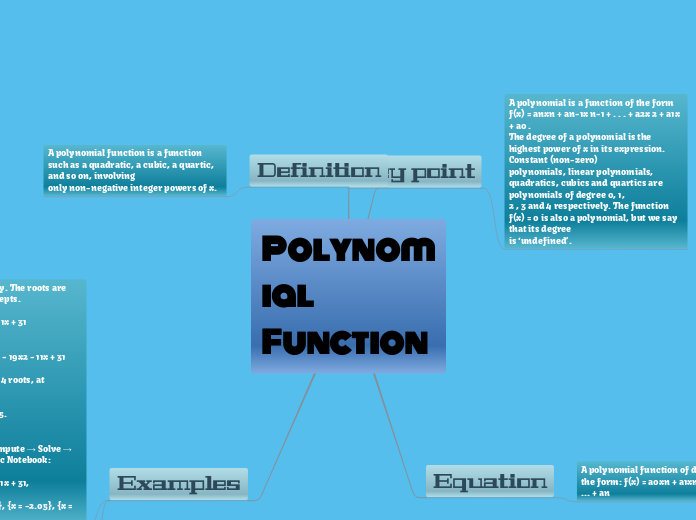Polynomial Function
Key point
A polynomial is a function of the form
f(x) = anxn + an−1x n−1 + . . . + a2x 2 + a1x + a0 .
The degree of a polynomial is the highest power of x in its expression. Constant (non-zero)
polynomials, linear polynomials, quadratics, cubics and quartics are polynomials of degree 0, 1,
2 , 3 and 4 respectively. The function f(x) = 0 is also a polynomial, but we say that its degree
is ‘undefined’.
Equation
A polynomial function of degree n is of the form: f(x) = a0xn + a1xn−1 + a2xn−2 + ... + an
where:
a0 ≠ 0 and
n is a positive integer, called the degree of the polynomial.
Definition
A polynomial function is a function such as a quadratic, a cubic, a quartic, and so on, involving
only non-negative integer powers of x.
Examples
Solution 1: Graphically. The roots are given by the x-intercepts.
f(x) = x4 − x3 − 19x2 − 11x + 31
Graph of f(x) = x4 − x3 − 19x2 − 11x + 31
We see that there are 4 roots, at approximately
x = -3, x = -2, x = 1, x = 5.
Solution 2: Using "Compute → Solve → Numeric" in Scientific Notebook:
f(x) = x4 − x3 − 19x2 − 11x + 31,
Solution is: {x = -2.97}, {x = -2.05}, {x = 1.02}, {x = 4.99}.
The number a is a root of the polynomial function f(x) if f(a) = 0, and this occurs when (x−a)
is a factor of f(x).
If a is a root of f(x), and if (x − a)
m is a factor of f(x) but (x − a)
m+1 is not a factor, then we
say that the root has multiplicity m.
At a root of odd multiplicity the graph of the function crosses the x-axis, whereas at a root of
even multiplicity the graph touches the x-axis.
